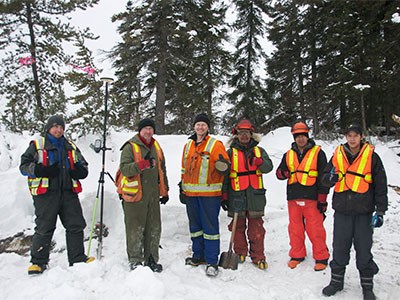It’s been well worth the wait for Weebigee.
Goldeye Explorations believes it’s just scratched the surface in unearthing a major high-grade gold find within the Sandy Lake greenstone belt in northwestern Ontario.
Based on a very successful winter drilling program, the Weebigee gold project – an Oji-Cree word for the goldeye fish – has quickly become the company’s flagship operation.
The company said it has produced some high density gold showings and they’ve identified a number of good targets, especially in the Knoll Zone.
“That’s the driver of everything,” said Robin Luke Webster, Goldeye’s manager of corporate affairs and community relations. “We’re drilling and hitting high grade (gold), so that will lead and the other stuff will follow.”
The main focus of exploration has been on the northwest arm of Sandy Lake.
Last summer at Knoll, one channel sample yielded 53.8 grams of gold per tonne, and another sample at its Bernadette Zone showed 43.5 grams gold.
They turned to the drill last winter and punched 22 holes in a 2,200-metre program that produced some eye-popping results.
One hole produced a 6.8-metre section grading 8.59 grams of gold and 2.6 metres grading at 18.96 grams. Another graded 6.71 grams over 5.5 metres and a third hole showed 6.76 metres over seven metres.
“Even before we had some assays there was so much amount of VG (visible gold) dispersed throughout the core that we had to put out a press release,” said Webster.
Goldeye has held ground in the Sandy Lake area for a long time, first staking claims in 1986-87.
Webster’s father, company president and CEO Blaine Webster, had his eyes on the area for many years dating back to when he was a geophysicist working with Inco’s exploration team in the 1970s.
But only a minimal amount of exploration has occurred in the ensuing years.
“The local communities weren’t ready for exploration to take place,” said Webster.
Yet the company had the patience to put exploration on hold and tend to other projects.
“He (Blaine) knew you can’t push these things,” said Robin. “The only reason we’re having any success now is because we’re working with the community and because Blaine’s approach was to respect the community.”
Sandy Lake is a remote First Nation town of 3,000 that’s 227 kilometres north of Red Lake. It’s accessible by land on a 350-kilometre winter road. The community is pushing hard for a permanent road.
With a land holding of 6,000 hectares, Goldeye’s 363 claim units are within a few minutes drive from town and its 3,500-foot airstrip.
“It’s remote but there’s excellent infrastructure,” said Webster.
A potential power source isn’t far off with the decommissioned Northwind Dam about 30 kilometres away. It would be a potential win-win for a future mining operation and for a community that wants off expensive diesel generators.
The whole area remains relatively underexplored.
The former Berens River Mine at Favourable Lake to the southwest — held by Golden Share Mining — last produced in the 1940s.
“If you talk to the Elders, there is a history of mining in the area, but in the last 60 years there has been almost nothing,” said Webster.
To solidify local support, the company painstakingly explained to the community what exploration entails, the environmental impacts, and what they were prepared to do to mitigate them.
Instead of flying in linecutters, Goldeye brought in a safety trainer to certify some local folks.
Rather than set up a bush camp, the exploration team stays at a motel on the reserve which helps pump money into the community.
“We spent a long time building a positive relationship with the community and last November we signed a five-year exploration agreement – and established a trust – with Sandy Lake First Nation and they now own a piece of Goldeye as a shareholder,” said Webster.
“We want to set an example and show that exploration can be done properly and be done in a way that brings really lasting benefits to the local population.”
The company has set aside $3 million for this summer’s exploration program, which includes a second phase of drilling starting in May.
A preliminary economic assessment is still a ways off, said Webster, who remains encouraged by investors’ confidence in the project.
“For this project, even with no drill holes, we were able to raise money. People believed that it had high potential and were willing to put some money into it.”




